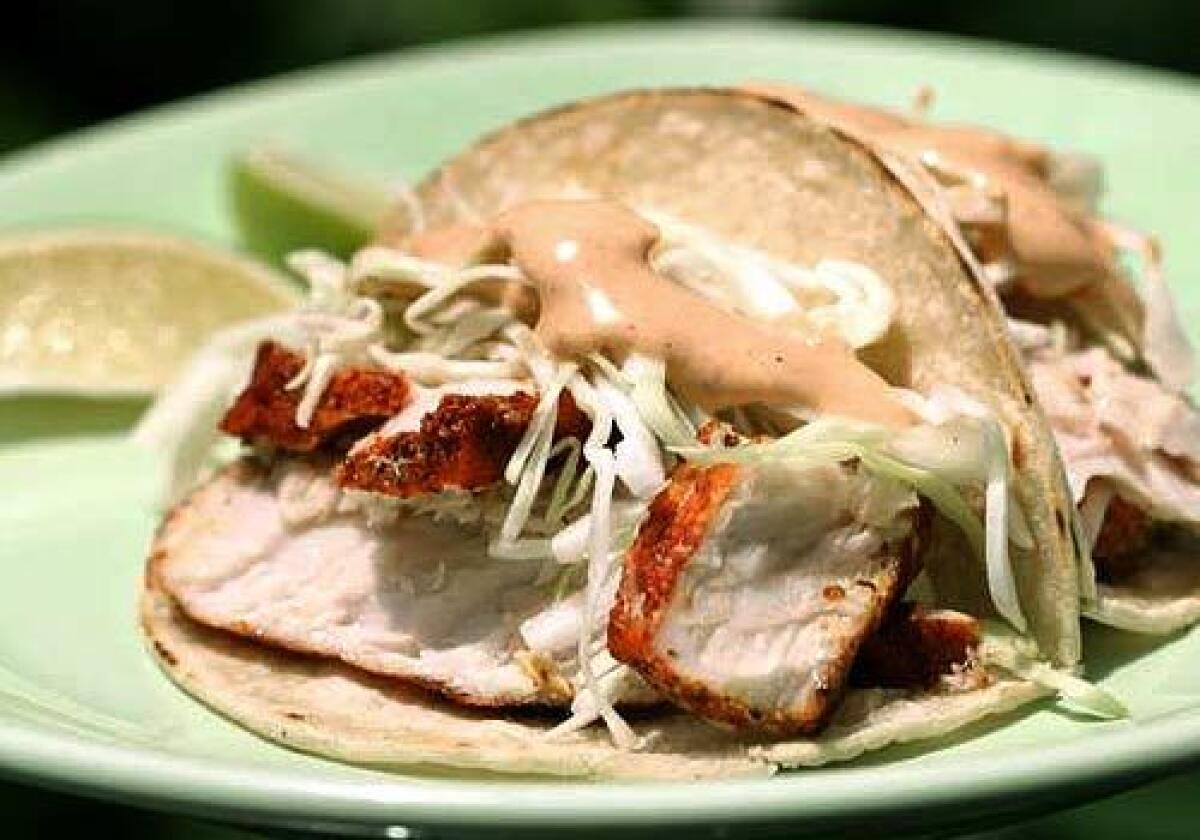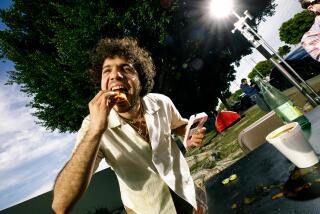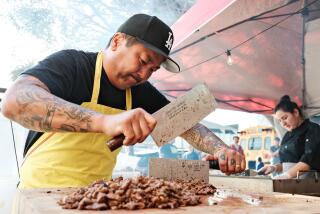Tacos get their glamour on

IT’S hard to pin down what’s great about a great taco. Is it the succulent, smoky carne asada? The tender, charred hand-made tortilla? The sweet, ripe, spicy brightness of pico de gallo? More likely it’s the way all those things come together.
You can find such taco greatness all over town, at corner taquerias and taco trucks with cult followings.
But the best tacos in the world might come out of your own kitchen. Imagine a warm corn tortilla filled with thinly sliced, pan-seared duck breast, tomatillo sauce and a cherry-chile compote. Or grilled lamb sausage with watercress and harissa. Or achiote-marinated yellowtail with shredded cabbage and chipotle mayonnaise.
Leave classics like tacos de barbacoa, carnitas and al pastor to your favorite neighborhood taco truck. When you’re inventing them at home, you can let your imagination take the wheel.
A terrific taco is about mouthfeel as well as flavor. There are no set rules about what goes into them; they’re more about improvisation, maybe a happy accident, some smart calibration. A hot rush of habanero chiles, then a cool tempering of crème fraîche or watermelon salsa. The rich succulence of leftover wine-braised short ribs, then a bright, fresh celery-leaf salsa. A little crunch, a little heat, a sudden burst of flavor. A well-orchestrated taco should seem like a sudden inspiration of flavors that coalesce at the very last moment.
Start with a good tortilla as the foundation. Fresh, handmade corn tortillas, from a local source or ones that you make yourself (it’s easier than you think), can make the difference between ordinary and extraordinary. If they’re not hot off your own comal, quickly heat them in a dry skillet or even right on the gas burner or outside on the grill.
Although flour tortillas can be amazing vehicles if they’re freshly made (they’re traditionally used in tacos in Sonora, Mexico), the richer flavor and rougher texture of a corn tortilla really elevate the dish. Corn’s subtle dimension is a terrific backdrop for other ingredients: Shrimp works beautifully with it, as does grilled fish; cherries and corn are unexpectedly wonderful together.
Then use the best ingredients, considering how their flavors will work together. The classic taco combos work because they rely on balance. The deep flavor of cochinita pibíl (pork slow-roasted in banana leaves) contrasts with the tart note of pickled red onions. The wonderful char of carne asada is offset by the fresh, bright flavors of pico de gallo. Grilled wild salmon rocks with a spicy cucumber-serrano salsa verde or a garlicky aioli.
A contrast of texture and temperature is important too. The cool crunch of shredded raw jicama plays deliciously against fat shrimp, still warm from a simmer in a rich, nutty pepita-cilantro sauce, just as the hot fried fish in a Baja-style taco gets cold crunch from raw cabbage as well as the reprieve of cool, luscious crema.
And all of it against the warm tortilla that envelops it — slightly chewy, redolent of the corn that adds yet another dimension.
Tacos don’t necessarily have to be built from the ground up — you can use last night’s grilled tri-tip or leg of lamb, or leftover dirty rice and beans. Even ratatouille. Just think of what would take those tacos to the next level. Grilled chorizo with that ratatouille, for example, or mint pesto and julienned radishes with those thin slices of leg of lamb.
Pile tortillas high with the leftovers from a fantastic daube or roast chicken, then mix up a quick salsa from the greens in your garden and the heirloom tomatoes now loading market stalls. Doctor a jar of mayonnaise or some sour cream, or just add a squeeze of lime or Meyer lemon.
The jolt and fire of one ingredient aligns with the cool notes of another, giving a balance but also creating quadrants of flavor. As the heat of chiles often operates on a kind of time release, the other ingredients you pair with them create layers of tastes and aftertastes. A cool dice of mangoes or grilled corn cut off the cob stretches out the fire of a serrano as it tempers it. A spoonful of sour cream can then offer both contrast and reprieve.
Serve and eat your haute tacos right as they come off the griddle and out of the kitchen — they’re immediate food, and the alliance of textures and temperatures are ephemeral.
Speed counts more than manners. The best tacos demand to be eaten bite by bite, with no more utensils than your hands. You fold the last nub of sauced tortilla into your mouth, brazenly lick aioli from your fingers, wipe errant chile sauce from your chin.
Had enough already? We didn’t think so. Just grab another — the possibilities are endless.
--
amy.scattergood@latimes.com
--Achiote-marinated fish tacos
Total time: About 50 minutes, plus 1 hour marinating time
Servings: 4
Note: The achiote paste recipe is adapted from “The Essential Cuisines of Mexico” by Diana Kennedy. Annatto seeds are available at Latino markets.
Achiote paste
4 rounded tablespoons achiote seeds (also called annatto seeds)1 teaspoon dried Mexican oregano
1 teaspoon cumin seeds
1/2 teaspoon black peppercorns
12 whole allspice
Mix the spices and grind them in batches in an electric spice or coffee grinder as finely as possible. In a small bowl, stir together the ground spices and enough water to make a stiff paste; we used about 3 tablespoons. You will have more achiote paste than is called for in the recipe. Store it well-wrapped in plastic in the freezer.
Chipotle mayonnaise
1 cup mayonnaise
2 garlic cloves, finely chopped
1 tablespoon olive oil
2 tablespoons lime juice
1/2 teaspoon kosher salt
3 chipotle peppers in adobo, roughly chopped
In a food processor or blender, blend the mayonnaise, garlic, oil, lime juice, salt and chipotle peppers. You will have more chipotle mayonnaise than is called for in the recipe. Keep in the refrigerator until ready to use.
Fish tacos
2 cloves garlic, peeled and crushed
1/4 teaspoon kosher salt
3 tablespoons achiote paste
1 pound yellowtail fillet, skin removed
1 tablespoon olive oil
8 small corn tortillas
1 cup finely shredded cabbage
1 cup chipotle mayonnaise
1 lime, cut into 8 wedges
1. In a small bowl, combine the garlic, salt and achiote paste. Put the mixture into a 1-gallon sealable plastic bag with the fish. Refrigerate for an hour.
2. On a cast-iron griddle or in a frying pan, heat the olive oil over medium-high heat. Scrape some of the extra achiote paste from the yellowtail, then grill the fish, about 6 to 8 minutes per side, or until done. If the fish is cooking too quickly or unevenly, adjust the heat as necessary. Let the fish rest for a few minutes before slicing it thinly across the grain; if the fish breaks apart, that’s fine.
3. Warm the tortillas on a pan over medium heat; place on a platter or individual plates, two per person.
4. Divide the fish among the tortillas and top with shredded cabbage and a teaspoonful of chipotle mayonnaise. Serve immediately, with lime wedges.
Each serving: 433 calories; 31 grams protein; 30 grams carbohydrates; 5 grams fiber; 22 grams fat; 3 grams saturated fat; 68 mg. cholesterol; 345 mg. sodium.
--Duck tacos with chile-cherry compote
Total time: About 1 hour, plus 1 hour marinating time
Servings: 4
2 teaspoons kosher salt, divided
1 1/2 pounds boneless duck breasts, skin on
10 dried chiles de arbol
6 ounces dried Bing cherries
1/4 cup plus 2 tablespoons olive oil, divided
5 cloves garlic, minced, divided
1/2 cup diced onion
6 tomatillos, husks removed, coarsely chopped
8 small corn tortillas
Finely chopped fresh cilantro for garnish
1. Rub 1 teaspoon of the salt into the duck breasts, place them in a large sealable plastic bag and refrigerate for 1 hour while you make the sauce.
2. Soak the chiles de arbol and dried cherries in 2 cups of boiling water for about 30 minutes. Drain, reserving the liquid. In a food processor, combine the drained chiles and cherries with one-fourth cup olive oil, one-half teaspoon salt and 2 cloves of the minced garlic. Process to a thick paste, adding a little of the reserved liquid to help combine and adjust consistency. Set aside. This makes about 1 cup compote.
3. In a medium, heavy-bottomed saucepan over medium heat, place the remaining 2 tablespoons of olive oil, the onions and the remaining 3 cloves of minced garlic. Sauté until the onions are just starting to caramelize, about 5 minutes. Add the tomatillos and remaining one-half teaspoon salt. Cover and continue to cook about 8 to 10 minutes, stirring occasionally, until the tomatillos are tender. Remove and cool slightly for a few minutes.
4. In a food processor, combine the tomatillo mixture with one-fourth cup of the chile-cherry paste. Set aside. This makes about 1 1/2 cups sauce.
5. Place the duck breasts, skin side down, into a cold, cast-iron skillet. Turn the heat to medium-high and cook the duck about 10 minutes, or until the skin is golden-brown and crispy and the fat has rendered off. (Turn the heat down to medium after a few minutes and watch to make sure the duck doesn’t burn. Adjust the heat if necessary so that it cooks evenly.) Turn the duck over and cook for 1 minute to cook the meat to medium-rare; otherwise, continue cooking until desired doneness is achieved. Remove the breasts to a cutting board and let rest for 5 minutes. Slice very thinly on the diagonal.
6. Heat a skillet over medium heat and warm the tortillas. Place two to a plate and divide the sliced duck among the tortillas. Spoon a tablespoon or so of the tomatillo sauce over the duck and add a half-teaspoon of chile-cherry compote on top, or to taste. Sprinkle the top with fresh chopped cilantro. Serve immediately.
Each serving: 565 calories; 37 grams protein; 42 grams carbohydrates; 6 grams fiber; 27 grams fat; 6 grams saturated fat; 174 mg. cholesterol; 464 mg. sodium.
--Shrimp tacos with pumpkin seed sauce
Total time: About 50 minutes
Servings: 4
Note: If you would like a spicier pumpkin seed sauce, double the amount of chiles.
1 bunch cilantro
1/2 cup sour cream
1/2 cup raw pumpkin seeds
2 tablespoons olive oil
2 cloves garlic
1 1/2 teaspoons kosher salt
1 serrano chile, seeded and inner ribs removed
1 jalapeno chile, seeded and inner ribs removed
1/4 large jicama, peeled
1 pound medium raw shrimp, peeled and deveined
8 small corn tortillas
Lime wedges
1. Finely chop about a third of the cilantro to yield 2 tablespoons, setting aside the rest. In a small bowl, mix the chopped cilantro with the sour cream and set aside.
2. In a medium sauté pan over medium heat, toast the pumpkin seeds until they pop and turn slightly golden, 8 to 10 minutes; do not let them brown. Set aside briefly to allow to cool.
3. In a food processor or blender, place the pumpkin seeds, olive oil, garlic, salt, chiles, remaining cilantro and one-half cup of water. Blend to a smooth paste.
4. Return the mixture to the sauté pan, add one-half cup of water and cook over low heat for about 20 minutes to develop the flavors. Stir frequently to make sure the sauce doesn’t burn and add more water if the sauce thickens too much or too quickly. Meanwhile, shred the jicama using a box grater. Refrigerate until needed.
5. Increase the heat to medium-high and add the shrimp. Cover and cook until the shrimp are pink, about 5 minutes, stirring and turning the shrimp occasionally for even cooking.
6. Heat a skillet or griddle over medium heat and warm the tortillas. Arrange two tortillas per plate, slightly overlapping. Divide the shrimp among the tortillas, add shredded jicama and a spoonful of cilantro sour cream. Serve immediately, with lime wedges.
Each serving: 471 calories; 32 grams protein; 33 grams carbohydrates; 7 grams fiber; 24 grams fat; 7 grams saturated fat; 185 mg. cholesterol; 365 mg. sodium.
More to Read
Eat your way across L.A.
Get our weekly Tasting Notes newsletter for reviews, news and more.
You may occasionally receive promotional content from the Los Angeles Times.







